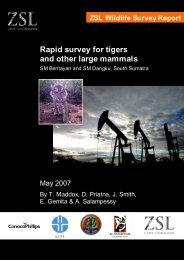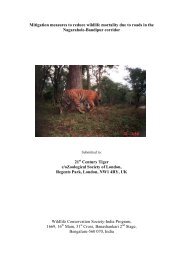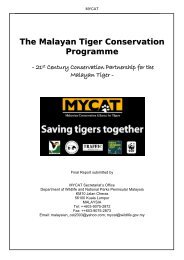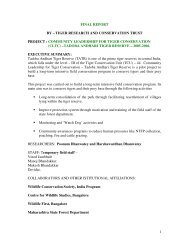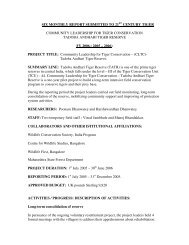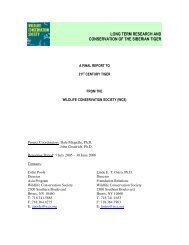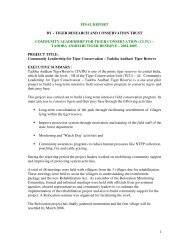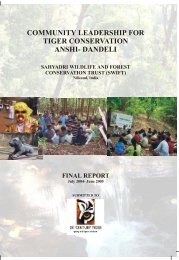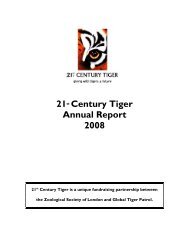The conservation of tigers and other wildlife in oil palm plantations
The conservation of tigers and other wildlife in oil palm plantations
The conservation of tigers and other wildlife in oil palm plantations
Create successful ePaper yourself
Turn your PDF publications into a flip-book with our unique Google optimized e-Paper software.
Environmental impact <strong>of</strong> <strong>oil</strong> <strong>palm</strong><br />
Oil <strong>palm</strong> represents a major direct threat to many <strong>conservation</strong> <strong>in</strong>terests. Initially this<br />
is through forest clearance. Oil <strong>palm</strong> <strong>plantations</strong> require high ra<strong>in</strong>fall, relatively flat<br />
l<strong>and</strong> <strong>and</strong> an altitude <strong>of</strong> below 200m - the exact same conditions as tropical lowl<strong>and</strong><br />
diptocarp forest. Consequently, <strong>oil</strong> <strong>palm</strong> production has an important role <strong>in</strong> forest<br />
clearance <strong>and</strong> the associated environmental problems, <strong>in</strong> particular when fire is used<br />
illegally for l<strong>and</strong> clearance. L<strong>and</strong> clearance fires are an annual occurrence <strong>in</strong> Indonesia,<br />
account<strong>in</strong>g for Indonesia’s rise to third largest producer <strong>of</strong> global warm<strong>in</strong>g gases <strong>in</strong><br />
the world, the highest <strong>of</strong> Kyoto signatories. In 1997 the Indonesian government<br />
accused133 <strong>oil</strong> <strong>palm</strong> companies <strong>of</strong> start<strong>in</strong>g massive forest fires, which were estimated<br />
to have burnt nearly 12 million hectares or 6% <strong>of</strong> the l<strong>and</strong> (Patzek <strong>and</strong> Patzek 2007).<br />
Further problems are caused by the layout <strong>of</strong> the <strong>plantations</strong>. Between harvest<strong>in</strong>g <strong>and</strong><br />
process<strong>in</strong>g <strong>oil</strong> <strong>palm</strong> fruit degenerates rapidly, mean<strong>in</strong>g it cannot be transported easily.<br />
Palm <strong>oil</strong> production is therefore most efficient when the crop grown <strong>in</strong> a large<br />
monoculture around a central process<strong>in</strong>g mill rather than <strong>in</strong> small-hold<strong>in</strong>gs<br />
<strong>in</strong>terspersed with <strong>other</strong> vegetation. Such large patches <strong>of</strong> monoculture, largely devoid<br />
<strong>of</strong> biodiversity, are far less compatible with <strong>conservation</strong> <strong>in</strong>terests than more<br />
heterogeneous agricultural production methods. F<strong>in</strong>ally, even after establishment <strong>oil</strong><br />
<strong>palm</strong> <strong>plantations</strong> reta<strong>in</strong> the potential to impact on local <strong>wildlife</strong> populations, through<br />
various management practices result<strong>in</strong>g <strong>in</strong> pollution or <strong>in</strong> <strong>in</strong>creased access to <strong>wildlife</strong><br />
areas with consequent disturbance <strong>and</strong> hunt<strong>in</strong>g.<br />
One <strong>of</strong> the biggest concerns for environmentalists is the sit<strong>in</strong>g <strong>of</strong> the proposed<br />
expansions <strong>of</strong> the <strong>palm</strong> <strong>oil</strong> <strong>in</strong>dustry. Whilst a presidential decree <strong>in</strong> 2006 stated that<br />
only idle l<strong>and</strong> could be used for <strong>plantations</strong> (Krismantari, 2007), def<strong>in</strong>itions <strong>of</strong> what<br />
constitutes idle l<strong>and</strong> are unclear. Accord<strong>in</strong>g to the Energy <strong>and</strong> M<strong>in</strong>eral Resources<br />
M<strong>in</strong>istry, environmental damage will be m<strong>in</strong>imal s<strong>in</strong>ce expansion is not planned <strong>in</strong><br />
protected areas (Krismantari, 2007); however, impacts which may further weaken the<br />
protected area system have not been <strong>in</strong>vestigated, <strong>and</strong> the M<strong>in</strong>istry’s statement makes<br />
the large <strong>and</strong> unsupported assumption that no potential for either <strong>conservation</strong> or<br />
environmental damage exists outside protected areas. Besides, as a recent editorial <strong>in</strong><br />
an Indonesian newspaper puts it, many believe “<strong>palm</strong> <strong>oil</strong>-based bi<strong>of</strong>uel development<br />
is too important to cancel simply because <strong>of</strong> criticism from environmental groups”<br />
(Jakarta Post Editorial, 2007).<br />
14 Wildlife <strong>conservation</strong> <strong>in</strong> <strong>oil</strong> <strong>palm</strong> <strong>plantations</strong>




